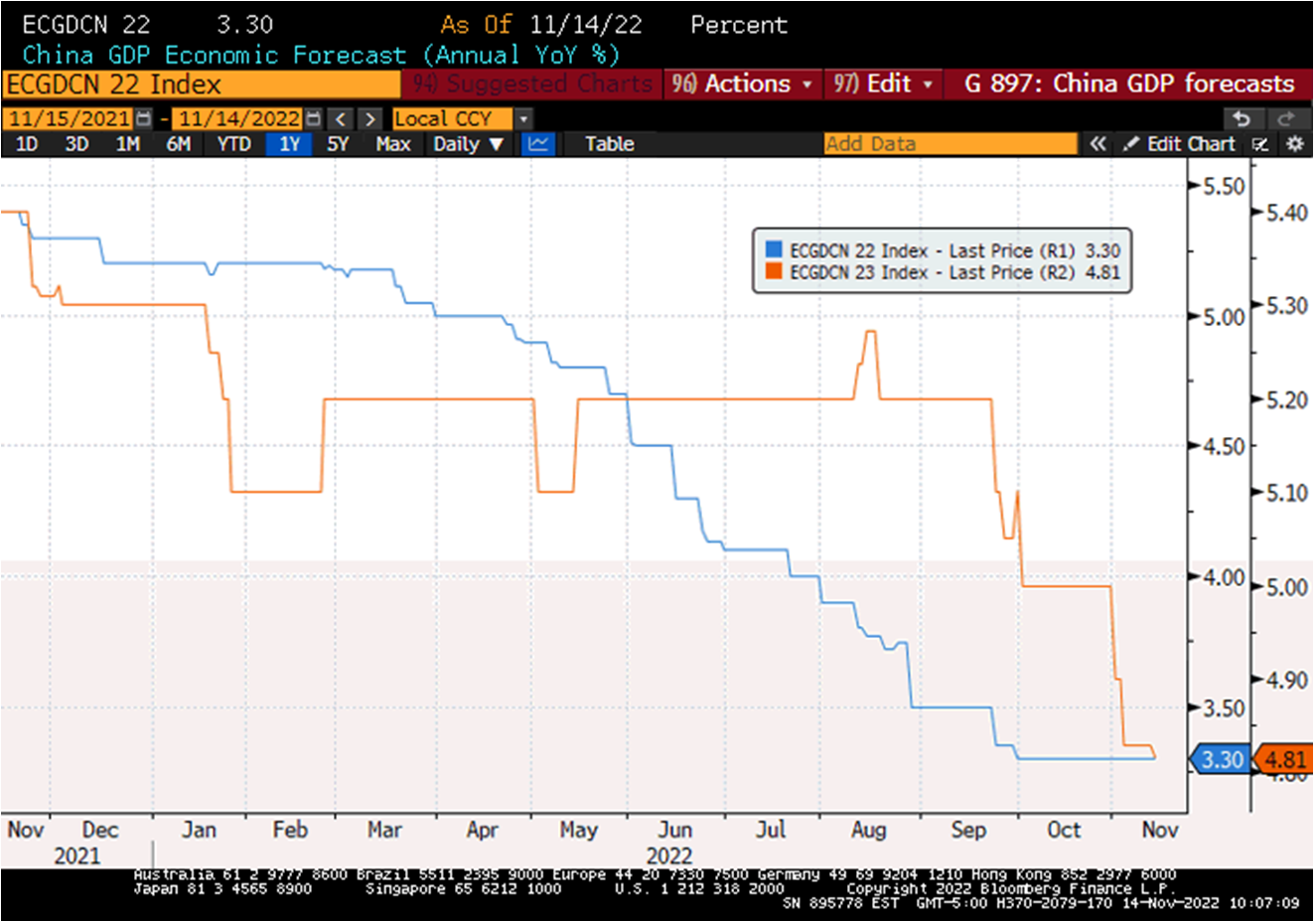China’s One-Two Policy Punch
14 November 2022
Read Time 2 MIN
China Policy Support
China’s growth concerns must have been really pressing, because the last week’s 20-point plan to ease some COVID restrictions was quickly followed by a 16-point plan to support the real estate sector. The new plan focuses on “stable financing” for companies (bond issuance, “reasonable” extension of existing construction loans, more bank lending – lenders might be absolved from personal responsibility if something goes wrong), and mortgage support for homebuyers (including “reasonable” mortgage extension). The plan also calls for equal treatment of state-owned and private real estate developers. It remains to be seen whether the latest policy moves will be true turning points for the growth outlook (see chart below) – implementation is key, as usual – but and at the very least they should reduce near-term risks associated with refinancing and liquidity in the housing/banking sector, and hopefully give a boost to consumer sentiment. As would be expected, many China’s names were doing really well this morning - but keep an eye on the next batch of China’s activity indicators after market close (just in case).
U.S. Rate Hikes
The global impact of China’s policy announcements was affected by comments made by U.S. Federal Reserve board member Waller, in which he said that rates should go higher and stay high to bring inflation back to target. The comment is a reminder that the pace of disinflation is now getting more important than the mere fact of leaving peak inflation behind. And it is reflected in the current market expectations for the Fed - Fed Funds Futures price in close to 100bps of additional rate hikes in the U.S. between now and March-May 2023, with the policy rate staying above 4% well into 2024.
EM Disinflation
The pace of disinflation will be closely watched by emerging markets (EM) central banks as well – in addition to other factors, like growth trends/growth cliffs and government policies, especially fiscal discipline. The latter is gaining in importance in Brazil, where President-elect Luiz Inácio Lula da Silva wants more social spending. Some senior members of the congress are pushing back – saying that they will support only a 1-year spending increase (2023) – but the market is not yet convinced: Brazil’s local bonds did worse than other GBI-EM constituents so far this month, and the local swap curve started to price in ~50bps of rate hikes in December-March. Stay tuned!
Chart at a Glance: China Consensus Growth Forecasts – Time For an Upgrade?

Source: Bloomberg LP
Related Insights
IMPORTANT DEFINITIONS & DISCLOSURES
This material may only be used outside of the United States.
This is not an offer to buy or sell, or a recommendation of any offer to buy or sell any of the securities mentioned herein. Fund holdings will vary. For a complete list of holdings in VanEck Mutual Funds and VanEck ETFs, please visit our website at www.vaneck.com.
The information presented does not involve the rendering of personalized investment, financial, legal, or tax advice. Certain statements contained herein may constitute projections, forecasts and other forward looking statements, which do not reflect actual results. Information provided by third-party sources are believed to be reliable and have not been independently verified for accuracy or completeness and cannot be guaranteed. Any opinions, projections, forecasts, and forward-looking statements presented herein are valid as of the date of this communication and are subject to change without notice. The information herein represents the opinion of the author(s), but not necessarily those of VanEck.
The views contained herein are not to be taken as advice or a recommendation to buy or sell any investment in any jurisdiction, nor is it a commitment from Van Eck Associates Corporation or its subsidiaries to participate in any transactions in any companies mentioned herein. This content is published in the United States. Investors are subject to securities and tax regulations within their applicable jurisdictions that are not addressed herein.
All investing is subject to risk, including the possible loss of the money you invest. As with any investment strategy, there is no guarantee that investment objectives will be met and investors may lose money. Diversification does not ensure a profit or protect against a loss in a declining market. Past performance is no guarantee of future results.
